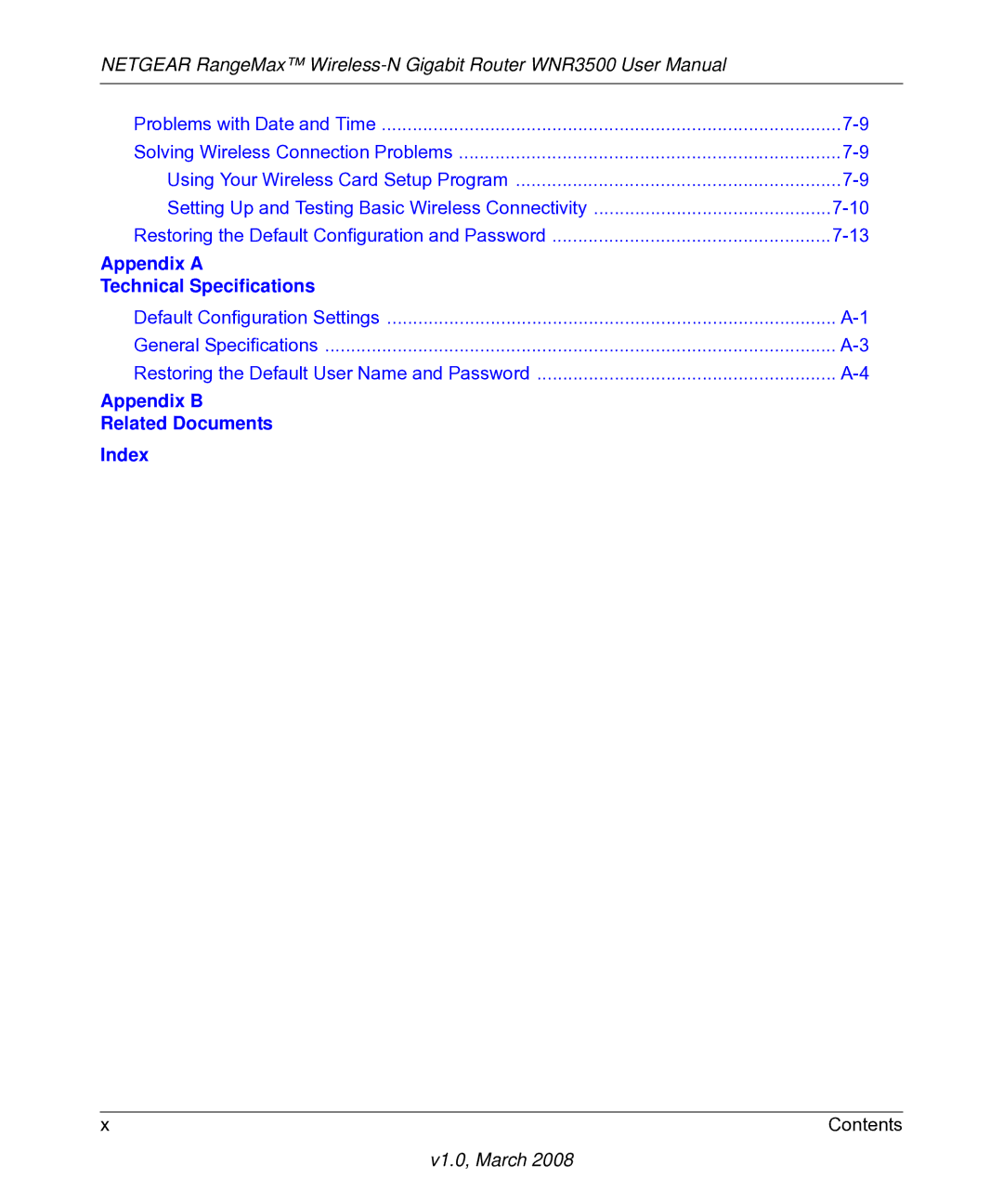Netgear RangeMax Wireless-N Gigabit Router WNR3500
Regulatory Compliance Information
Europe EU Declaration of Conformity
FCC Information to User
FCC Requirements for Operation in the United States
FCC Guidelines for Human Exposure
FCC Declaration Of Conformity
FCC Radio Frequency Interference Warnings & Instructions
Product and Publication Details
Contents
Chapter Restricting Access From Your Network
Chapter Using Network Monitoring Tools
Appendix B Related Documents Index
About This Manual
Conventions, Formats, and Scope
How to Use This Manual
How to Print This Manual
Revision History
Publication Revision History
Xiv
Chapter Configuring Basic Connectivity
Using the Setup Manual
Logging In to Your Wireless Router
V1.0, March
V1.0, March
Viewing and Configuring Basic ISP Settings
ISP does not require login
V1.0, March
ISP does require login
V1.0, March
V1.0, March
Chapter Safeguarding Your Network
Choosing Appropriate Wireless Security
Security options
Wireless data
Range up to 300 foot radius
Wireless Security Options
Security Type Description None
Other Features That Enhance Security
Security Type Description Disable the wireless router radio
Recording Basic Wireless Settings Setup Information
Changing Wireless Security Settings
Viewing Basic Wireless Settings
V1.0, March
V1.0, March
Configuring WEP Wireless Security
Configuring WPA-PSK and WPA2-PSK Wireless Security
V1.0, March
Viewing Advanced Wireless Settings
Available settings in this screen are
Push Button Configuration
Using Push N Connect Wi-Fi Protected Setup
Using the Physical Push Button
Using the Software Button in the Add WPS Client Screen
Using the Wireless Client’s Security PIN
Using the Router’s Security PIN
Security PIN Entry
Configuring the WPS Settings
Adding Additional WPS-Enabled Clients
Restricting Wireless Access by MAC Address
Adding Additional Non-WPS-Enabled Clients
V1.0, March
Select the Turn Access Control On check box
Changing the Administrator Password
Backing Up Your Configuration
Understanding Your Firewall
V1.0, March
Content Filtering Overview
Restricting Access From Your Network
Blocking Access to Internet Sites
Restricting Access From Your Network
Blocking Access to Internet Services
Configuring a User-Defined Service
Blocking Services by IP Address Range
Scheduling Blocking
Viewing Logs of Web Access or Attempted Web Access
Configuring E-mail Alert and Web Access Log Notifications
Log Entry Descriptions
V1.0, March
Setting the Time
V1.0, March
Chapter Customizing Your Network Settings
Using the LAN IP Setup Options
Configuring a Device Name
Configuring LAN TCP/IP Setup Parameters
Using the Router as a Dhcp Server
Using Address Reservation
Using a Dynamic DNS Service
Select the Use a Dynamic DNS Service check box
Setting Up a Default DMZ Server
Configuring the WAN Setup Options
Disabling the SPI Firewall
Setting the MTU Size
Responding to a Ping on the Internet WAN Port
Configuring Static Routes
Configuring NAT Filtering
V1.0, March
Wireless Repeating Also Called WDS
Wireless Repeating Function
Setting Up the Base Station
Setting Up a Repeater Unit
Fill in the Base Station MAC Address field
V1.0, March
Chapter Fine-Tuning Your Network
Allowing Inbound Connections to Your Network
Fine-Tuning Your Network
How Port Triggering Changes the Communication Process
V1.0, March
How Port Forwarding Changes the Communication Process
Configuring Port Forwarding to Local Servers
How Port Forwarding Differs from Port Triggering
Adding a Custom Service
Editing or Deleting a Port Forwarding Entry
Application Example Making a Local Web Server Public
Configuring Port Triggering
Clear the Disable Port Triggering check box
Click Add Service
Using Universal Plug and Play
Optimizing Wireless Performance
Identify critical wireless links
Configuring Quality of Service
Reduce interference
Using WMM QoS for Wireless Multimedia Applications
Configuring QoS for Internet Access
QoS for Applications and Online Gaming
QoS for a Router LAN Port
Click Add Priority Rule
QoS for a MAC Address
Editing or Deleting an Existing QoS Policy
Changing the MTU Size
MSN
Optimizing Your Network Bandwidth
Common MTU Sizes
V1.0, March
Overview of Home and Small Office Networking Technologies
Assessing Your Speed Requirements
Theoretical Transfer Time for 1 Gigabyte
Chapter Using Network Monitoring Tools
Viewing Wireless Router Status Information
Wireless Router Status Fields
1describes the router status fields
Dhcp
Connection Status Settings
Router Statistics
Managing the Configuration File
Viewing a List of Attached Devices
Backing Up and Restoring the Configuration
Erasing the Configuration
Upgrading the Router Software
Upgrading Automatically to New Router Software
Upgrading Manually to New Router Software
Enabling Remote Management Access
Select the Turn Remote Management On check box
Troubleshooting Quick Tips
Chapter Troubleshooting
Be sure to restart your network in this sequence
Make sure that the Ethernet cables are securely plugged
Check the Test light to verify correct router operation
Power light is not on or is blinking
Troubleshooting Basic Functions
Lights never turn off
Wireless light is not on
Troubleshooting the Web Configuration Interface
Internet or Ethernet port lights are not on
Troubleshooting the Internet Connection
V1.0, March
Troubleshooting a Network Using the Ping Utility
Testing the LAN Path to Your Router
Testing the Path from Your Computer to a Remote Device
Ping -n 10 IP address
Solving Wireless Connection Problems
Problems with Date and Time
Using Your Wireless Card Setup Program
Setting Up and Testing Basic Wireless Connectivity
V1.0, March
V1.0, March
Restoring the Default Configuration and Password
V1.0, March
Default Configuration Settings
Appendix a Technical Specifications
Table A-1. WNR3500 Router Default Configuration Settings
Wireless
General Specifications
Table A-2. WNR3500 Router General Specifications
Restoring the Default User Name and Password
Appendix B Related Documents
Document Link
V1.0, March
Index
Index-2
Index-3
Index-4
Index-5
Index-6
